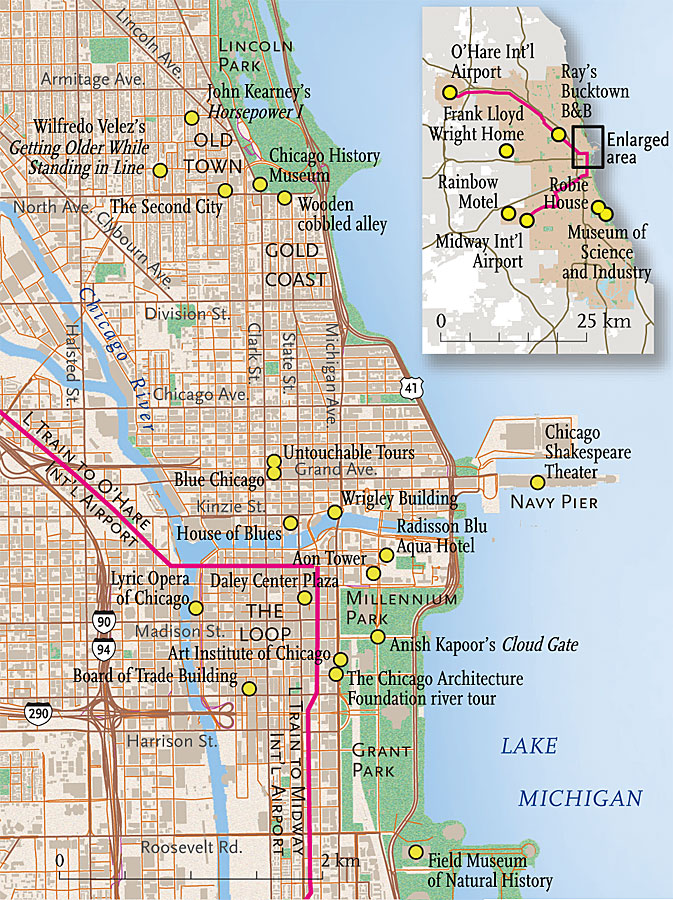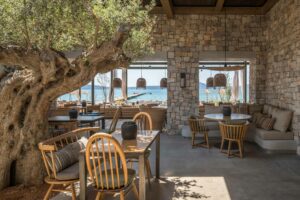
Travel
How to stop a gold rush
The new movement building flourishing tourism hubs across Canada – one sustainable example at a time
- 3297 words
- 14 minutes
This article is over 5 years old and may contain outdated information.
Travel


Now I know what Toronto’s problem is: to build a truly great city by a Great Lake, you need a convenient fire to wipe out everything and start fresh. Notwithstanding all the death and destruction, that’s how it happened in Chicago in 1871. Visionary architects and politicians who think that art and culture oxygenate the lifeblood of a city also go a long way to making Chicago world-class.
This is the American city to visit if you appreciate a wellturned cornice or a particularly sexy flying buttress. Chicago takes its buildings seriously, and not just those designed by starchitects such as Frank Lloyd Wright. How seriously? The Chicago Tribune has an almost-daily architecture blog and regular architecture column. Art, too, is clearly valued here, not only in the city’s many galleries but also on its streets. You’re as likely to stumble across a sculpture as a park bench in some neighbourhoods. And to best appreciate those unique corners of the city, Chicago boasts some of the finest guided tours around.
But my four-day whirlwind visit revealed far more than just great art, architecture and tours. Indeed, there’s something for everyone in this superb city, from an impressive roster of museums that will have history buffs and families in hog heaven to a vaunted arts scene that includes comedy, opera and, of course, the blues.
Your trip can begin easily and in expensiv ely. Heading downtown on the “L” (Chicago’s metro) from Midway International Airport, I am first struck by the fact that I can ride a train from the airport into the city, and for just a few dollars. I can also actually hear the announcements, not just garbled drive-through window static. A well-modulated voice tells me not to solicit or gamble. This is the first hint that Chicagoans are strangely coy about their gangster past. Over the next few days, I can’t find any tours dedicated solely to Al Capone and Chicago’s claim to fame as America’s incubator for organized crime. Not even the Chicago History Museum, where they hardly shy away from the macabre, is forthcoming. Here, the bed upon which Abraham Lincoln expired is on display, along with the disconcerting detail that his 6’4” frame didn’t fit so he had to be laid out diagonally. The museum also pays homage to the city’s bloody past as the hog butchery capital of the world, but there is not one whiff of Capone. I wonder why. A non-scientific survey of guides, bookstore and museum employees tells me it’s not something Chicago’s tourism authorities like to promote. Pity.
The official party line on the city’s architecture, however, is justifiably over the top. The best introduction to Chicago’s many iconic buildings is found on the Chicago Architecture Foundation’s River Cruise. The guides are volunteers who really know their stuff. One, Lindy Trigg, spoke extemporaneously for 90 minutes. While cruising past the stately Wrigley Building, for example, I learn that William Wrigley Jr., came to Chicago to sell soap powder. The gum was just a giveaway, intended as a sales gimmick. And then there was this tidbit: the third tallest building in Chicago, the Aon Center, built in 1973, was originally clad in Italian Carrara marble, the same material Michelangelo used to sculpt David. The only problem was that to save a buck, the stone was cut too thin and a huge chunk fell off. The building eventually had to be stripped and was re-clad with five-centimetre-thick granite, at a cost of about $80 million U.S. — probably one of the world’s most expensive facelifts. By the way, does anyone think the imposing Board of Trade Building looks like a giant armchair, Trigg asks? That’s due to a 1920s ordinance that skyscrapers of a certain height couldn’t just go straight up. A similar stipulation in New York resulted in buildings that resemble tiered wedding cakes, Trigg says, noting that “Chicago’s look like Art Deco furniture.” And they do. Before the tour is over, I am pleased to spot a sideboard.
Art lovers will disembark from the river cruise inspired to visit some of its highlights. There’s no better place to start than The Art Institute of Chicago. Here, I discover that Henri de Toulouse- Lautrec’s famous lithograph poster Ambassadeurs: Aristide Bruant is literally much larger than life. Stumbling across Van Gogh’s The Bedroom, a particularly striking work, is a happy accident — I didn’t realize it was part of a vast permanent collection that includes Grant Wood’s American Gothic and Jackson Pollock’s The Key.
But you don’t have to go to a gallery to sample some of Chicago’s inspiring art — it’s everywhere. It helps that since 1978 every municipal building and public space has had to earmark at least 1.33 percent of the cost of construction or renovation to original artwork on site. There are the biggies, such as the unnamed Picasso at Daley Center Plaza (it looks a lot like a horse), or, in Millennium Park, Anish Kapoor’s 100-tonne Cloud Gate (commonly known as “The Bean”); like everyone, I can’t resist taking a cheesy photo of myself reflected back in its seamless surface made of 168 welded plates of burnished stainless steel. Keep your eyes open for less celebrated pieces too. Wandering through chi-chi Old Town, just north of the central business district known as The Loop, and the exclusive Gold Coast, a little further northeast, I trip over a few gems. Another equine installation, John Kearney’s Horsepower I, is made entirely from old steel car bumpers. Nearby, outside St. Michael’s Church, Wilfredo Velez Jr’s whimsical fibreglass resin piece Getting Older While Standing in Line won’t be damaged by snowplows, because the city carefully boxes each vulnerable installation before winter.
Travelling on foot through Chic ago’s neighbourhoods is, in fact, the best way to discover the cultural peculiarities of any given part of the city. In the Gold Coast, there’s a $400,000 patch of alleyway made of wooden blocks rather than stone. This unique surface was installed to demonstrate what roads were like before the great fire, when wooden blocks were cheaper than cobblestones. With wooden roads soaked in creosote, it’s no wonder one third of Chicagoans were left homeless after the great fire. These expensive replicas are, thankfully, creosote-free. A little further on, my guide from the Chicago Greeter program and I pass by a home with 4.3-metre palm trees planted in the tiny wedge of garden out front. We stop. Palm trees? In Chicago? How do they survive the winter? The owner happens by as we gawk at his house. “We get out a big saw and cut them down,” he explains, before adding that the trees get replanted every spring. I’m beginning to understand how the $400,000 expenditure for some wooden blocks got the green light in Chicago’s toniest neighbourhood.
The wealthy aren’t the only ones to benefit from expensive refurbishments. While the Field Museum looks, feels and smells the way it probably did when it moved to its current location in the King Tut-mad 1920s, inside are some decidedly modern additions. Restoring Earth is a touchy-feely, iPadinspired, 557-square-metre permanent exhibit dedicated to conservation. In it, kids touch screens to learn about scientists in the field, who come across more like Dr. Indiana Jones than Dr. Sheldon Cooper of “The Big Bang Theory.” You can dial into a microscope to view a handful of sediment and the shells of some 1,743 known mollusks found in the Florida Keys. (Until the Field scientists started investigating in 1992, we only knew of 582 in that area of the Keys.) A reconstructed Egyptian tomb is worth the visit, as is the Grainger Hall of Gems. Apart from the shiny, pretty objects it holds, the latter is also home to a paleontologist and gemologist’s dream: an opalized section of vertebrae from a plesiosaur — a nod, perhaps, to the museum’s most famous occupant, Sue, who sits at the far end of the soaring main atrium. At 12.3 metres long and 1.78 metric tonnes, she is the world’s largest, most intact and best-preserved Tyrannosaurus rex. Sidle up under her massive jawbone and you’re guaranteed a shiver.
Another museum great for kids and adults who want to know the ins and outs of everything is the Museum of Science and Industry. It is appropriately located on the former site of one of the wonders of another age: the 1893 World’s Fair. The fair attracted 27 million visitors to its modern marvels, which included the first Ferris wheel, commissioned in an attempt to out-Eiffel the Eiffel Tower. It did, standing 25 storeys. Today, the museum bills itself as the largest science centre in the western hemisphere, and the importance that Chicago places on its treasures is clear. Take U-505, for instance. Captured in 1944 by Chicagoan Captain Dan Gallery, the submarine was eventually brought to his hometown and put on display outside in 1954. When 50 Chicago winters took their inevitable toll, the museum undertook a huge restoration project. A subterranean hall was constructed in front of the museum and the submarine lowered in. The result was a massive and impressive war exhibit preserved forever. (Pay the extra money for a guided tour of the U-boat: the engine room still reeks of diesel.) The museum also houses an exhibit called Science Storms, featuring a 12-metre-tall fog tornado, a tour of a replica coal mine and a chick hatchery.
After a day of drinking in as much architecture, art and history that you can, why stop? Chicago is renowned for its theatres and music scene, so take in a show and soak up the city’s vibe. Famed comedy club The Second City is worth a visit, even if you can’t get tickets. Wander by to see the intricate terra cotta façade, originally commissioned by Frank Lloyd Wright’s mentor Louis Sullivan. Inside, get a kick out of the framed letters of outrage imploring the theatre not to “promote Satan” hanging alongside portraits of its alumni greats, from Joan Rivers to John Candy. Alternatively, head for the lights of Navy Pier, which lives up to its reputation as Illinois’s number one tourist attraction/ trap with a collection of shops, restaurants, bars, rides and other entertainment. If a play’s your thing, you’re in luck; the Chicago Shakespeare Theater is located here, an elegant counterpoint to the wonderful shlockiness surrounding it. More rarefied still is the nearby Lyric Opera of Chicago, one of the world’s best. For a distinctly more gritty (but no less enjoyable) musical experience, you can’t go wrong kicking back at one of the city’s many blues bars. Enjoy live music every night of the week at Blue Chicago, where it doesn’t take much imagination to believe for a minute that it’s 1929 and you’re tippling bootlegged whiskey in a speakeasy. Vestiges of Capone’s Chicago, it seems, can still be found.
Are you passionate about Canadian geography?
You can support Canadian Geographic in 3 ways:

Travel
The new movement building flourishing tourism hubs across Canada – one sustainable example at a time

Travel
Jill Doucette, founder and CEO of Synergy Enterprises, shares insights on new trends in the tourism industry and why there’s reason to be optimistic about a sustainable future for travel

Travel
Travel writer Meghan J. Ward gives her best tools to help you gain context and a deeper understanding of the places you visit

Travel
Where to stay, what to do and how to make the most out of your time in Costa Navarino